Greiz is a Kreis (district) in the east of Thuringia, Germany. Neighboring districts are Saale-Holzland, Saale-Orla, district-free city Gera, the Burgenlandkreis in Saxony-Anhalt, Altenburger Land, and the two Saxon districts Zwickau and Vogtlandkreis.
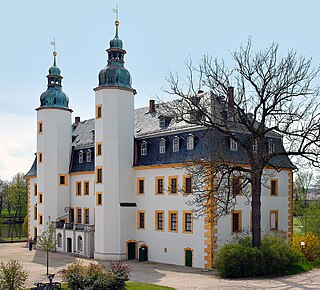
Blankenhain Castle is a large castle in Blankenhain near Crimmitschau, in the district of Zwickau in Saxony, Germany.

Schwarzenberg is a town in the district of Erzgebirgskreis in Saxony’s Ore Mountains, near the German–Czech border. The town lies roughly 15 km southeast of Aue, and 35 km southwest of Chemnitz.
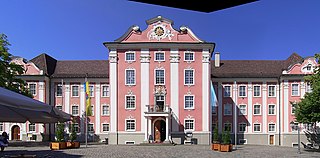
The Neues Schloss Meersburg is located in Meersburg near Lake Constance in Baden-Württemberg, Germany. From its construction in 1750 until the bishopric was dissolved in 1803 it was the seat of the Prince-Bishop of Constance.

Schloss Oldenburg is a schloss, or palace, in the city of Oldenburg in the present-day state of Lower Saxony, Germany. The first castle on the site was built around 1100 and became the ancestral home of the House of Oldenburg. The present building served as residence to the counts (1667–1785), dukes (1785–1815) and grand dukes (1815–1918) of Oldenburg.

Osterstein Castle is the former castle of the town of Zwickau, Germany, in Saxony. Now it houses a nursing home.

Landestrost Castle is a castle in the Weser Renaissance style that was built between 1573 and 1584 in Neustadt am Rübenberge in the north German state of Lower Saxony. Integrated into fortifications, together with the town, it developed into an urban fortress typical of the 16th century. The castle was the representative residence and administrative headquarters of its master, Duke Eric II of Brunswick-Lüneburg. During the construction period from 1574 he renamed the town of Neustadt as Landestrost, something which was reverted after his death in 1584.
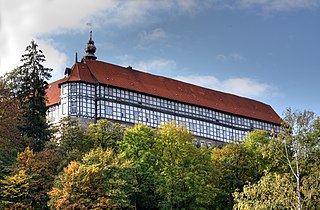
Herzberg Castle is a German schloss in Herzberg am Harz in the district of Göttingen in the state of Lower Saxony. The present-day, quadrangular building has its origins in the 11th century as a medieval castle. After a fire in 1510 it was rebuilt as a schloss and is one of the few in Lower Saxony that was constructed as a timber-framed building. Because it belonged to the House of Welf for 700 years it is also known as the Welf Castle of Herzberg.

The Ore Mountain Toy Museum in Seiffen is an internationally known museum of Ore Mountain toys and Ore Mountain folk art. It was opened in 1953 in Seiffen. In 1973 it was joined by the Ore Mountains Open-Air Museum, a folk art and local historic museum with 14 houses typical of the Ore Mountains before 1900 on the edge of the toy village.

Pillnitz Palace is a restored Baroque schloss at the eastern end of the city of Dresden in the German state of Saxony. It is located on the right bank of the River Elbe in the former village of Pillnitz. It was the summer residence of many electors and kings of Saxony; it is also known for the Declaration of Pillnitz in 1791.

The Marburger Schloss, also known as Landgrafenschloss Marburg, is a castle in Marburg, Hesse, Germany, located on top of Schlossberg. Built in the 11th century as a fort, it became the first residence of Landgraviate of Hesse (HRE). The Marburg Colloquy was held here in 1529.

The hunting lodge of Augustusburg was built from 1568 to 1572 above the town of the same name on a hill called the Schellenberg on the northern edge of the Ore Mountains of Germany. The castle, which is visible from afar, is a local landmark. It lies about 12 kilometres east of the city of Chemnitz and about 21 kilometres southwest of Freiberg in the Free State of Saxony.

Stolberg Castle is a palace in the town of Stolberg in the Harz Mountains of Germany. It dates to the 13th century and stands above the town on a hill with steep drops on three sides. Since 2003 it has been completely restored and renovated by the German Foundation for Monument Conservation.
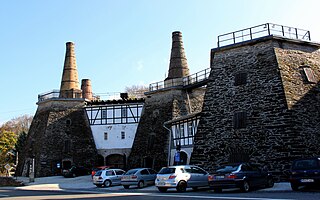
The Lengefeld Lime Works was a limestone mine southwest of Lengefeld in the Saxon town of Pockau-Lengefeld in the Ore Mountains. In 2016, the mine was closed.

Rochsburg Castle, which was probably founded in the late 12th century, stands on a rock spur, surrounded on three sides by the Zwickau Mulde river, above the eponymous town quarter in Lunzenau in Saxony. The medieval site and its division into the inner bailey, outer bailey and two zwingers is still easy to recognise. In its present appearance the schloss dates, however, to the Late Gothic and Renaissance periods. Its main construction phases date to 1470 and 1548; it is an important example of Renaissance architecture in Saxony. Over centuries the Rochsburg has formed the centrepiece in the Saxon district of Rochsburg.
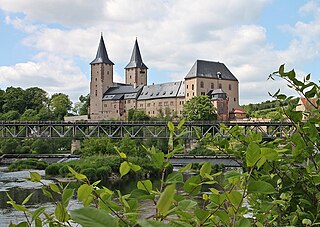
Rochlitz Castle or Rochlitz Palace lies in the west of the town of Rochlitz in the county of Mittelsachsen in the Free State of Saxony. It was built on the site of an imperial castle, erected in the second half of the 10th century, which fell into the possession of the Wettin margraves in 1143. Its appearance, which includes several Romanesque wings, is considerably influenced by its remodelling into a margravial schloss in the fourth quarter of the 14th century. Further conversions and additions followed at the end of the 15th and in the 16th centuries, when the castle became a secondary residenz, dower house and hunting lodge for the Wettin family. The castle or palace was the residence for members of the Saxon princely house eight times. From the 18th century the castle served as an administrative centre ; in 1852 it became a gaol, which necessitated considerable alteration. The museum founded in 1892 was gradually expanded and, today, takes up almost the entire castle.

Wildeck Castle or Wildeck Palace is an old hunting lodge in Zschopau in Saxony. It stands on a rocky spur above the River Zschopau.

Schloss Weesenstein is a Schloss located in Weesenstein, a small village, part of Müglitztal in the Müglitz river valley, around 3 kilometres (1.9 mi) south of Dohna in Saxony, Germany.

Schloss Wolfenbüttel is a castle in Wolfenbüttel, Lower Saxony, Germany. An extensive four-wing complex, it originated as a moated castle (Wasserburg). It is the second-largest surviving schloss in Lower Saxony and served as the main residence of the rulers of the Principality of Brunswick-Wolfenbüttel from 1432 to 1753. It now houses a gymnasium secondary school, the Federal Academy of Arts Education, and a museum with its historic rooms on display. Its immediate vicinity is home to several historically significant buildings including the Herzog August Bibliothek, the Lessinghaus, the Zeughaus, and the Kleines Schloss.


















